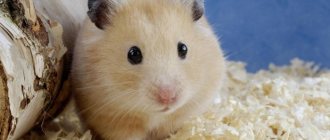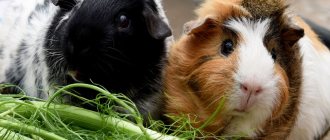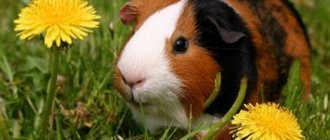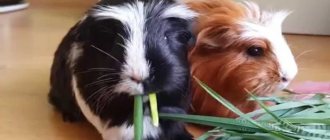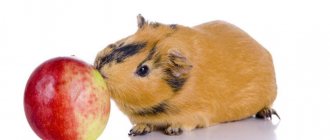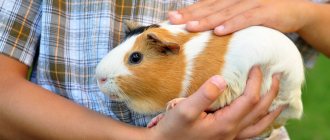Mechanical wounds
If a wound appears, the guinea pig should be treated with an antiseptic.
Before treatment, it is necessary to clean the damaged area, remove dirt, hair, and rinse well. When washing, a solution of potassium permanganate in proportions of 1:1000 works well. 3% hydrogen peroxide will also work. After treatment and drying, the injury site should be anointed with an ointment with a disinfecting effect. These are streptocidal and prednisolone. The ointment can be replaced with a bandage with streptocide. The wound must be treated every day until it heals.
- conjunctivitis - inflammation of the mucous membrane of the eyes;
- infection with ectoparasites that have a detrimental effect on the quality of the guinea pig’s coat and skin;
- infection with parasites that destroy the internal organs of the pig: trichomoniasis, cystitis, fascioliasis, salmonellosis;
- Otitis externa is an inflammation of the ear canal.
How are guinea pigs vaccinated?
A veterinarian should vaccinate your pet rodent. He conducts a clinical examination and reviews laboratory data. Urine and blood tests are usually performed. Healthy, well-fed animals with a body weight of at least 500 g can be vaccinated. The animal must have clean, dry eyes and nose. The pig should be active and eating well.
The first vaccination for guinea pigs is carried out at the age of 4-5 months. The specialist gives the animal an intramuscular injection of the drug, repeated after 10 days. It is advisable to vaccinate at home to reduce the stress of transportation and visits to the veterinary clinic.
Owners of guinea pigs should not doubt the need for annual vaccinations for their furry pet. Annual vaccination prolongs the life of pets and eliminates the possibility of small and large owners of this funny animal becoming infected with deadly diseases.
Are guinea pigs vaccinated?
Before reading this article, I didn’t think about whether vaccinations are necessary for a guinea pig. It’s very good that I found this article in time; the author of the article described in detail and clearly what vaccinations it is advisable to give to an animal. I consider this article useful and necessary for many lovers of these animals.
Guinea pigs are the cutest small rodent pets, they really only bring joy and smiles. They, like small children, are afraid of drafts and it is clear that any cage must be clean so that your pet does not have any health risks. And regarding vaccinations, I’ve never heard that guinea pigs need them.
As far as I know, vaccinations are very rarely given to these animals, and for a nursery you need a room, if you just have cages there and put pigs there, but then you will be a breeder
You know, to be honest, I was surprised that guinea pigs are never vaccinated, as the author of this article writes! I thought that pigs, like cats, are vaccinated against rabies, for example. But the article states that it is enough just to keep a newly acquired guinea pig in quarantine for two weeks to understand that it will not harm the health of others and other pigs.
The article is called “Vaccinations for Guinea Pigs,” but in fact there is nothing about vaccinations except one sentence. But the article turned out to be interesting nonetheless. It briefly describes the pigs themselves and covers the topic of caring for the animals in sufficient detail. I completely agree with the author that first of all you need to keep the cage clean. Hygiene must come first. The emphasis is correctly placed on the need to protect pigs from drafts and provide fresh vegetables and fruits.
Interesting article. I learned a lot of new things! But, with all due respect to the author, I believe that it is mandatory to vaccinate guinea pigs. After all, even if you don’t walk outside with your pig, you can bring the infection into the house on your outer clothing or on your hands. Why make your pet suffer with your own hands! And of course, you need to be careful about your pig’s living conditions.
Excellent article, written very concisely and informatively. Like the author, I also thought that there are no vaccinations for guinea pigs in nature. We have had three rosette guinea pigs for six years now, and indeed, as the article says, they are extremely hardy and unpretentious, the main thing is to follow simple rules of care
For beginners, it will be important to learn how to keep the cage clean, protect your pets from drafts, and diversify their diet as much as possible with cereals and various types of fresh vegetables.
I actually doubted for some time whether it was necessary to vaccinate guinea pigs. It's good that there is no need. They are generally animals with good health. But they can catch a cold from a draft
You also need to move them very carefully, close the cage tightly, and keep an eye on them if you let them out for a walk, because guinea pigs are very “fragile.” They could seriously hurt themselves if they fall.
| Your name: |
| Your Email: |
| A comment: |
| Verification code: |
Worms
All antiparasitic drugs are toxic. Worms in pigs can be seen in the feces with the naked eye. If they are not visible, then idling weed will only weaken the body, and will also lower the immune system and have a bad effect on the liver.
How to treat: Dirofen paste, Shustrik for rodents, Prazicide suspension for kittens are suitable. Use according to instructions, calculate dosage by weight!
Worms and other endoparasites are poisoned based on their presence (based on the results of tests in a veterinary clinic or veterinary laboratory). Don’t be lazy to submit fresh feces (preferably straight from mumps) for analysis. Contrary to the opinion of “experts,” there are no preventive measures.
A recent study (Kaulfß 2010) on preventive baiting of intestinal parasites in sheep (herbivores) showed that parasites develop resistance to anthelmintic drugs if it is used:
– without making a diagnosis – very often (every 6 months or more often) – in a low dosage – always the same active substance – without monitoring the success of baiting parasites
If at least a couple of worms survive baiting with the drug, they develop resistance to it. Moreover, these new qualities are passed on to the next generation of worms. Since there are no studies on rabbits and pigs yet, experts on these animals advise sticking to data on the behavior of parasites in other herbivores.
PIGS ARE NOT VACCINED.
Guinea pigs do not need vaccination, they do not suffer from viral and other diseases, like, for example, rabbits and other rodents. Pigs are treated externally with drops and a suspension against endo- and ectoparasites.
As an example, I give a veterinary certificate for a guinea pig f. 4, which states that pigs are not vaccinated.
Source
Necessary for care
Like any other pet, a guinea pig requires a wide variety of grooming accessories. These include:
- cage or aquarium;
- feeder;
- sippy cup;
- house;
- filler;
- mineral stone;
- toys;
- carrying;
- hygiene products;
- brush-comb and nail clipper.
Cage or aquarium
Keeping a guinea pig is allowed both in an aquarium and in a cage. The main condition is size: the dwelling must be at least 50 cm in length and 30 cm in height so that the animal can move comfortably. If you have decided on a cage, then it is best to take a closer look at the options that have a plastic bottom. Plastic is quite easy to care for, it is easy to wash, dry, etc. A wooden base is not suitable due to the fact that these animals drink a lot of liquid per day, and therefore excrete a large amount of urine. The wood will simply become unusable in a very short time. You can purchase an aquarium in the above sizes. It, like a cage with a plastic bottom, is easy to wash and clean. But you should be careful, since glass is a very fragile material and when moving it, for example, to another room, you should follow safety rules (the pet should not be in the aquarium, it should be transferred to a carrier).
cell
Feeder
The feeder should be heavy enough so that the guinea pig cannot knock it over. An excellent option would be bowls made of ceramics, stainless steel, etc. It is also recommended to buy 2-3 containers. For example, one will be used for vegetables or fruits, and the second for dry food.
Sippy cup
A vertical ball sippy cup is perfect for a guinea pig. It is usually made of plastic with a metal tip. In such a drinking bowl there is no need to change the water daily, but this is done about 2-3 times a week.
House
Be sure to install a small house in the cage or aquarium. Your pet will sleep in it, relax, or simply retire when he wants to be alone. Most often, such houses are made of wood with a round “door” cut out in the middle. The most optimal size is 25 cm in length and 15 cm in height. This space is enough for the animal to hide and at the same time feel comfortable.
house
Filler
When arranging the cage, do not forget about the bedding. It will create comfort in the cage, prevent the animal from freezing and, to some extent, maintain cleanliness. You can use sawdust or ground corn cobs as a filler. Under no circumstances put cotton wool, newspaper, paper, etc. in the cage as bedding, as this is not safe for your pet’s health.
Mineral stone
To maintain dental health and calcium levels in your guinea pig's body, mineral stone is essential. After all, it serves not only as a vitamin complex, but also perfectly helps the animal grind its teeth. This stone is sold in a pet store, and its price is quite affordable.
stone
Toys
Guinea pigs are somewhat similar in behavior to decorative rabbits. They love to play. Therefore, be sure to buy some interesting and funny toy for your pet, for example, a tunnel, a hammock, a mirror, a rolling wheel, etc. The game will not only bring joy and pleasure to the animal, but will also strengthen muscles, and will also be an excellent preventive measure against obesity.
Carrying
If your plans did not include traveling together or any trips with your guinea pig, then you will still need a carrier. Transporting an animal in your arms, in a box or blanket is strictly prohibited. For example, you need to visit a veterinarian or transport the animal to another house or apartment; in such life situations, a carrier will definitely help you out. The pig will feel safe and the transportation process will go smoothly.
Hygiene products
Guinea pigs are considered clean animals, but sometimes they are still allowed to be bathed. For such cases, it is necessary to use special hygiene products that can be purchased at a pet store. The most popular of them:
- "Biogance" - bio-perfume;
- "Veda" - wheat shampoo.
Brush-comb and nail clipper
Caring for your guinea pig's coat and claws is extremely important. To do this, you need to purchase a special comb with soft bristles (combing is done daily), as well as a nail clipper for trimming the claws (the procedure is performed as they lengthen).
First meeting
If you place two unfamiliar animals in the same dwelling, a ritual of acquaintance and establishment of rank will take place between them. In this ritual, sniffing and trying to jump on each other's backs are standard actions. Guinea pigs chatter their teeth and try to jump on each other. You should not create obstacles to their acquaintance. All that is required from the animal owner is patience.
Establishing a rank often lasts several days, after which the animals behave peacefully.
Due to the fact that pigs also have their own personalities and dislikes, before purchasing a new pet, you need to carefully consider whether it suits your group.
Expert advice: before placing a new animal in a cage with a group, you need to rub the back of its body with the litter that is already in the cage in which you want to place it. As a rule, after this the animals accept the newcomer as one of their own. This method helps when meeting for the first time in a neutral area.
During this period, the cage should be washed and filled with the necessary accessories. It is necessary to make a small rearrangement of the animals' housing. Housing for the group must accommodate a house for each pig. In the first few weeks, food should be scattered throughout the cage to eliminate possible conflicts between pets.
If the breeder sees that rodents are fighting, the following measures must be taken:
- Knock loudly near the cage. An unexpected sharp sound distracts the animals.
- Spray warm water on the animals.
- Try to separate them manually using rough gloves.
- The conflict is over. Now, for some time, the pigs need to be moved to different rooms. And start getting to know each other again.
Based on all of the above, we can conclude:
The male needs to be castrated. This will help dull the animal's protective instincts. The process of sterilization of females is more complicated. It is recommended to purchase pigs while they are still young. For example, take a young animal of the same sex as an adult animal. It is worth raising two animals together from an early age, this way you will eliminate the incompatibility of animals. Guinea pig is a small but strong animal
If the animal is angry, you must handle it carefully so as not to get a scratch. The animal can be aggressive; during a fight, it can bite through the skin of another pig.
You should not place an unsterilized male with a female. These animals reproduce quickly.
Does a guinea pig have rabies?
Guinea pigs are considered animals with strong immunity. Many owners of such rodents believe that they practically do not get sick. With proper feeding and regular care, a guinea pig gets sick very rarely and, as a rule, lives a relatively long (by animal standards) life - 9-11 years. But, nevertheless, like any other living beings, guinea pigs are also not immune to various diseases, the success of treatment of which directly depends on the state of the rodent’s immune system. All rodent diseases are divided into infectious and non-infectious. The first category includes viral and bacterial, the second - genetic diseases, diseases of all parts of the internal organs - gastrointestinal, heart and respiratory diseases. Worm infestations can be either an independent disease or accompany more serious illnesses. Mixed diseases also occur against the background of chronic diseases, since the animal’s immunity is weakened and the guinea pig becomes susceptible to infections.
Infectious and viral diseases of guinea pigs include: infectious paralysis, pseudotuberculosis, rabies, viral diarrhea or enteritis. These diseases can be transmitted from other guinea pigs, in particular through the bite of an infected animal, not necessarily a rodent (rabies). To avoid infecting your toothy ward with infectious diseases, you need to know and adhere to safety measures: do not put foreign animals that you know nothing about in the same cage with your pet. When purchasing a new guinea pig, it is a wise idea to quarantine it in a separate cage where it will not have contact with your pet. The quarantine period is 30 days, during this period all hidden diseases will go into the active phase and will be visible, but if the animal is healthy after this period, then you can safely place it with other animals.
Non-infectious diseases often occur from improper care and poor nutrition of guinea pigs. Poor quality or stale food can cause poisoning or diseases of the stomach and intestines. The food must always be fresh. Leftover food must be removed from the cage, especially for perishable foods and bread. Stick to a diet specifically for rodents.
Worm infestations can cause long-term illness or even death in a guinea pig. Anthelmintic drugs for rodents are available in veterinary pharmacies. This procedure must be carried out 3-4 times a year. It must be remembered that owners of any animal must also take anthelmintic medications annually for prevention.
Signs of a sick animal may be the following: refusal to eat, lethargic behavior, unnatural movements. Losing hair and “scabies” can serve as signals that your pet has parasites - fleas and scabies mites. In this case, there is no need to “observe” the animal, but urgently show it to veterinary specialists, since these animals have an increased metabolism, and a serious illness can be lightning fast.
(Website materials used: https://msvinkadoma.wordpress.com).
Causes: occurs from a weakened immune system. This is facilitated by a poor diet, stress, and poor living conditions. Dirty litter provides fertile soil for the proliferation of fungal spores. If pigs are kept in close quarters, skin fungus can easily affect all animals.
Symptoms: Thinning coat, bald spots, flaking, dandruff, white coating on the skin. The affected skin may be itchy (the pig constantly scratches certain areas or chews the skin in the affected area). In this case, there is a high risk of secondary infections, since bacteria can get into areas scratched until they bleed.
How to treat: Be sure to adjust your diet. Fungi and other diseases appear, for the most part, with reduced immunity. The following sprays and ointments are suitable: Clotrimazole, Thermikon spray, Fungoterbin, Lorinden S, Lamisil spray. Shave the pig with a clipper if the skin damage is significant. If the area is small, then cut the hair around it. They cut or shave so that infectious skin flakes do not spread and the affected area is clearly visible, which needs to be smeared, covering another 0.5-1 cm from the sides.
What can you feed your guinea pig?
Kevi have a special digestive system. Roni food is consumed frequently and in small portions.
Juicy food
Juicy food includes vegetables, fruits and berries. This is not the main food for guinea pigs, but is necessary for maintaining an active lifestyle and health.
With vegetables, the body receives the necessary amount of fiber, which promotes the functioning of the digestive system. When eating fruit, the guinea pig receives the necessary vitamins.
What can a guinea pig eat from vegetables, fruits and berries:
- Carrot;
- Zucchini;
- Cucumber;
- Pumpkin;
- Beet;
- White cabbage;
- Cauliflower;
- Bell pepper;
- Turnip;
- Swede;
- Sweet corn;
- Tomatoes;
- Green pea;
- Apples;
- Pears;
- Citrus;
- Apricots;
- Nectarines;
- Peaches;
- Plum;
- Pitted cherries;
- Raspberries;
- Strawberries.
Before feeding your animal a new vegetable or fruit, it is better to consult a veterinarian.
You should give from 3 to 5 different vegetables and fruits per day. Alternate them every day
However, it is important to give them to your guinea pig correctly. Either several types of vegetables at one time, or several types of fruits. For example, you should not feed plums and beets at the same time.
For example, you should not feed plums and beets at the same time.
The daily food intake is divided into 2 or 3 meals. It is better to feed succulent food in the first half of the day.
In the afternoon, you can give mainly green food and hay.
Hay and green fodder
Hay should always be in the feeder. You can prepare it yourself, or purchase it ready-made at a pet store.
You can make your own hay from meadow grasses.
Green fodder cannot be collected along the road. It is better to collect grass in a field or forest. To make hay, it must be dried for 1-2 months.
The grass should not be wet, rotten or rotted. Before feeding green food to an animal, it must be washed and dried.
Guinea pigs are herbivores. They chew hay constantly. They need it to grind down their teeth and normalize the digestive system.
What herb can you give:
- Nettle;
- Plantain;
- Dandelion;
- Alfalfa;
- Clover;
- Chamomile;
- Yarrow;
- Carrot tops;
- Beet tops;
- Raspberry leaves;
- Strawberry leaves;
- Currant leaves;
- Dill;
- Parsley;
- Lettuce leaves.
Water
Water must be in the cage at all times. Do not use tap water. You can take bottled or filtered water.
What else can you give?
In order for a guinea pig to wear down its teeth, it must be given tree branches to chew on. Branches should be collected away from the road. Before feeding, the branches must be cleared of dirt and washed under running hot water.
Which tree branches can be given:
- Birches;
- Linden trees;
- And you;
- Apple trees;
- Pears;
- Cherries;
- Rowan trees.
In addition to food, the animal needs vitamins. The kewi's body is designed in such a way that it cannot obtain vitamin C from regular food. A lack of this vitamin leads to various diseases, so additional feeding is necessary.
One adult should be given 5-15 mg of ascorbic acid daily. The vitamin can be dissolved in a glass of water and poured into a drinking bowl.
How much should you feed?
You need to feed your guinea pig 2 or 3 times a day. In this case, the daily feed intake is divided into 2 or 3 times, respectively.
In the first half, most of the succulent feed, part of the hay and granulated feed are fed. In the second half there are the remains of succulent food, a lot of hay and the remains of granulated food.
If you increase the dose of pelleted food, this can lead to obesity.
Guinea pig vaccination
Despite their long life span for domestic animals, guinea pigs are often susceptible to infections. Infectious diseases are of fungal, bacterial and parasitic nature.
Often, pig owners do not know how much their pet needs vaccinations. However, these vaccinations are given to yourself, children and other pets regularly. Despite the fact that domestic guinea pigs live in good conditions and not on the street, they still need to be vaccinated. And for those animals that walk outside, vaccination is simply necessary, since in nature they come into contact with other animals and eat what is edible, grass, etc.
Why are vaccinations needed?
Pigs, coming into direct contact with sick brethren or other pets, risk becoming infected.
Moreover, they can catch the disease, which can then be transmitted to humans:
- Tuberculosis.
- Listeriosis.
- Rabies.
- Salmonellosis.
- Pasteurellosis.
- Dermatophytoses.
Guinea pigs are vaccinated not only to prevent infection of the animal and then the owner with diseases, but also to develop the protective function of the pet’s body against infection.
Frequent illnesses
In guinea pigs, the weakest point is the eyes. Do you know anything about diabetic cataracts? It is quite common in humans and dogs.
This disease is manifested by the following symptoms. A white stripe appears between the front of the eye (cornea) and the sclera. This place is called limbus, which means beach in Latin. This mass forms a bone on the outside of the eye, which encourages the formation of another bone, which should not happen. This is called heteroscopic bone formation.
This disease in guinea pigs passes quickly and is very difficult to treat. But there is no need to be afraid, you should know what to do in this case.
Pseudotuberculosis is a chronic disease that is manifested by the formation of nodes on the affected organs and tissues. An animal can become infected with this disease through food. The causative agent is bact.pseudoruberculosis rodentium.
Signs of an animal infection:
- loss of appetite;
- the pig is losing weight;
- stool is disturbed;
- the animal was paralyzed.
#4 28.09.2009 23:03:58
Re: Porpoise
Hello! I have a question - almost a month ago I bought a guinea pig, a 2 month old male, rosette. He was active, ran, squeaked, jumped, ate a lot, drank a lot, always slept in the opposite edge of the cage from the drinking bowl on dry sawdust. Always very curious. Now something is happening to him and I’m afraid that I won’t be able to help him in time - he’s stopped being active, sleeps a lot, always lies under the drinking bowl, on the wet, all wet, doesn’t run, hardly eats, stool is normal , there are no visible changes either. Please tell me what could be wrong with him, is he sick? I really want to help him, I really don’t want to lose him.
Do guinea pigs need to be vaccinated?
We all received vaccinations as children.
No one has even a shadow of doubt about the importance and necessity of this procedure. The vaccine is injected into the body using a syringe.
Vaccination stimulates our immune system to protect against a particular infectious disease. What, in general terms, is the point of vaccination? The vaccine contains weakened or killed pathogens of various infections. They help develop immunity to specific pathogens.
People get sick, animals get sick. Everyone has their own weak points and vulnerabilities. These places are well known to medicine. Animals develop immunity to the most dangerous diseases (threat to their lives) and, in addition, are deprived of the opportunity to transmit the disease to people or other animals.
Are there vaccines (and vaccination schedule) for guinea pigs? No, they don't exist. These animals spend most of their lives in home “greenhouse” conditions in their cage houses. Therefore, the practice of vaccinating guinea pigs has not become widespread. Your guinea pig only needs regular veterinary preventive care.
It is important to be able to independently recognize the symptoms of your pet’s ailments and promptly contact a specialist for help.
What difficulties might you encounter? The main ambush is that guinea pigs hide their ailments from their owners until the last moment. However, these animals are very sensitive to various types of infections and are susceptible to pain. If an animal is sick, its condition can worsen by leaps and bounds
That is why it is necessary to pay close attention to the health of a small pet, not to bring it to the point where no one and nothing can help it.
What is the most common problem with guinea pigs? In the first place we will put such a problem as vitamin C deficiency. Pigs do not synthesize this vitamin on their own; it enters the body from the outside. A proper and balanced diet rich in vegetables and fruits is the key to the health of your guinea pig. The animal suddenly loses its appetite, looks “bloated”, weak, moves reluctantly, and has severe diarrhea - these are the main symptoms of vitamin C deficiency.
Ulcers and swelling on the pads of the feet. The condition is officially called “ulcerative pododermatitis.” The disease develops when the pet runs on a very hard and rigid surface (for example, bare chicken wire). Pododermatitis causes pain and discomfort to the animal. We advise you to provide bedding for your pet made of soft, non-traumatic materials. Use fleece or linoleum.
Subcutaneous mites. These microscopic parasites relatively often affect guinea pigs. As soon as you notice that your pet is scratching intensely and its fur is coming off in clumps, this means you need to start treatment. Fortunately, the disease can be effectively treated, but you will have to contact a veterinarian.
Dental problems. Guinea pigs' teeth grow throughout their lives. The front incisors, in particular, become sharpened naturally - for example, when eating food. Pigs are also given a mineral stone or wooden blocks in their cage. We have universal advice for all times: always have fresh hay in the diet and a sufficient amount of leafy vegetables.
Summary list of anxiety symptoms. Please memorize them or learn them by heart. If you notice at least one, immediately contact your veterinarian for advice and help. So: dramatic weight loss; labored breathing; sneezing and as if caked eyes; rough, uneven coat; insensitive, “unseeing” eyes; unnatural posture; lethargy; profuse drooling; diarrhea or watery stools; blood in urine; hair loss; excessive scratching.
It is a pity that there are no universal effective vaccines for guinea pigs. But the owners of these wonderful animals have all the levers to intervene in time and help their pets.
Where are dogs' belly buttons? How to make friends between a cat and a dog? Why does a hedgehog laugh? The entire encyclopedia about animals is on our website.
Source
For the elderly and children
Is this why EpiVacCorona is aimed at children and the elderly?
Sergei Balakhonov: The first stage of mass testing will still be carried out on a group from 18 to 60 years old. Also, according to the developer, a separate post-registration clinical study of 150 volunteers over 60 years of age will be conducted later.
Why are elderly people and children given special attention when vaccinated?
Sergey Balakhonov: As a rule, unfortunately, most older people have chronic diseases. They, as the coronavirus pandemic has already shown, tend to become sharply activated and worsen when infected with SARS-CoV-2
This is the reason for caution
Children are also at risk due to the characteristics of the growing body and the immaturity of natural immunity to many diseases. These age restrictions are a global practice for testing and researching new vaccines.
What can you say about cases of repeated infections with COVID-19?
Sergei Balakhonov: As part of the research on the level of population immunity of the population of the Irkutsk region, which is conducted by the Anti-Plague Institute, not a single re-infection with coronavirus infection has been identified.
In the meantime, we have reliable data that the immunity formed after suffering from COVID-19 is determined after 5-6 months in a fairly high titer. And this gives us optimism. The study of coronavirus continues.
Vaccinations. Need advice.
Vaccinations. Need advice. ¶
From: nady - April 6, 2008 4:32 pm
Dear breeders! This question has arisen. Is it possible for pigs to receive vaccinations that are intended for rabbits? A veterinarian I know said that there is a massive death rate of guinea pigs in Moscow. The symptoms are almost identical for everyone. Mostly females and cubs die, less often males. The animal becomes lethargic, lies down more, some lose their hind legs, etc. He believes that this is a viral infection and advised vaccinating pigs with a vaccine for rabbits. There is a version that it was a mutated rabbit disease virus, VGBV. I don’t claim that this is really true, but there is such a version. Share your experience and opinions.
Vaccinations. Need advice. ¶
Case. Where is the case? Breeders, owners! This is true. Who has a case? I'm really worried
Vaccinations. Need advice. ¶
From: nady - April 6, 2008 4:42 pm
I was told this information when I went to get my dog vaccinated. At the same time I asked if it was possible to vaccinate pigs? To which I was given this answer.
Vaccinations. Need advice. ¶
From: KsyuKha - April 6, 2008 18:20
Pigs are not vaccinated, especially not with a vaccine for rabbits. Pigs do not get this disease.
People began to have more mumps, and accordingly they began to bring in more sick people. It is necessary to feed a more balanced food for each age.
Vaccinations. Need advice. ¶
From: nady - April 6, 2008 6:30 pm
What about small nurseries or those who have 1-2 pigs? The feeding there is very good. Many sinned on food, many switched to high-quality imported food. But the pigs still die.
Vaccinations. Need advice. ¶
From: iskra - April 6, 2008 7:14 pm
I agree with Ksyukha. Everything comes from feeding. Hind legs are taken away in three cases: when the spine is injured, when the stomach is sick and from a lack of vitamin C. Let’s discard the first, but for the second I’ll say this: With proper treatment, everything goes away, in advanced cases the animal dies.
This is an inflammatory bowel infection. Eimeria are protozoan parasites that can cause hind leg failure. The hind legs are paralyzed, the joints are swollen and the legs almost do not bend. The pig refuses to eat. He falls on his kick and moves his paws, apparently when he has strong spasms. I'm not a vet. I am a doctor, so I am writing my observations. We went through this successfully. The microbe is introduced with food. The disease is treated with baytril and rimadyl.
And there is also the so-called “bunny” - this is the same failure of the hind legs, but from a lack of vitamin C. It happens that the pig is given it, but the body does not absorb it well or does not absorb it at all. At the same time, the pig does not refuse food, but jumps like a bunny, dragging both hind legs at the same time. The joints also enlarge. Treatment is an increased dose of vitamin C. Add ascorbic acid to the drinking bowl. In severe cases, inject ascorbic acid with glucose. Give cabbage, sour apples, parsley and other vegetables and fruits containing a high percentage of vitamin C.
I’m not sure about mortality in nurseries, since both are purely individual and depend on the individual characteristics of one or another individual. But maybe I'm wrong.
Last spring, I first wrote this one, time flies so quickly, because it’s spring again, three females were sick with me: one with “bunny” and two with eimeriosis, or, as it is called there, medically. Fresh grass had just begun to emerge. Apparently she brought it with her. But the whole nursery ate, and only two got sick, and a month later another one, but this time as a “bunny.” So it's not contagious. Mine all recovered and gave birth successfully.
lice eaters
Lice eaters and other visible parasites appear from contact with other pigs; infection is possible through hay, sawdust, unsealed food from a pet store that sells infected animals, etc. Lice eaters are not dangerous to humans.
Symptoms: itching is possible (but not always), small worms about 1 mm long are found in the fur, they look yellowish on black wool, darkish on white.
- Sprays for cats and rodents are suitable, for example, 8in1 spray, Acaromectin, Bars spray for cats, Bolfo spray, Celandine spray, etc. Breeders use Frontline for cats and dogs, but, for example, Frontline is toxic for rabbits. Therefore, there are conflicting opinions about it, especially judging by foreign forums and articles that prohibit the use of fipronil-based drugs on rabbits and rodents.
- You can buy a spray against lice and nits at a pharmacy. The same active ingredient is used as in sprays against lice for animals - permethrin.
- The best option is Stronghold drops for kittens or Advocate. You need 1 pipette, not a whole box. Dosage is strictly based on weight. Stronghold – 6 mg selamectin per 1 kg of animal weight, which corresponds to 0.1 ml/kg for 6% solutions and 0.05 ml/kg for 12%. Advocate – 0.1 ml per 1 kg of pig.
It is better to use drops : you need to spray the entire pig with sprays (spraying the drug all over the body is unsafe - the animal can lick itself when washing), and drop the drops on the withers or on the bald patch behind the ear and release the clean pig. Read the instructions carefully before using any product (otherwise, you may poison the animal). Pay attention to the dosage, the number of sprays.
Be sure to wash the cage and all its accessories, change the bedding, food and hay.
The number of treatments depends on whether, in addition to lice eaters, there are also nits. If parasite eggs are also attached to the hairs, then a single treatment will not be enough. It will need to be repeated after 14 days (since permethrin and other insecticides only affect adults, but not their eggs).
Important. Never use Neostamazan, Ethnomazan, Stomazan, Butox to treat pigs. Unfortunately, many veterinarians unknowingly prescribe them. It is used ONLY to treat surfaces, not living creatures. Animals often die from these drugs. Initially, they were used for cattle, against ectoparasites. Why this product was even introduced into our pet stores for decoration is unclear. And the instructions clearly state that it is used for livestock, cats, and dogs. There is no talk of any smaller and/or exotic animals there. Quotes from owners whose animals have experienced the sad consequences of this drug:

